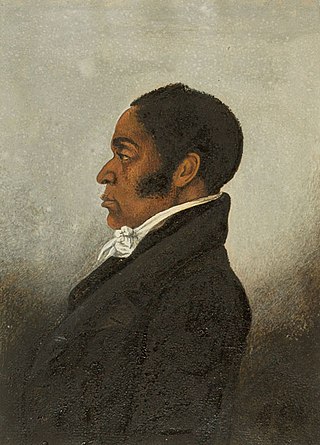
James Forten was an American abolitionist and businessman in Philadelphia, Pennsylvania. A free-born African American, he became a sailmaker after the American Revolutionary War. Following an apprenticeship, he became the foreman and bought the sail loft when his boss retired. Based on equipment he himself had developed, he established a highly profitable business. It was located on the busy waterfront of the Delaware River, in an area now called Penn's Landing.
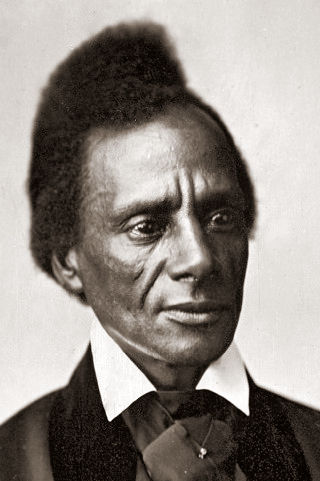
Charles Lenox Remond was an American orator, activist and abolitionist based in Massachusetts. He lectured against slavery across the Northeast, and in 1840 traveled to the British Isles on a tour with William Lloyd Garrison. During the American Civil War, he recruited blacks for the United States Colored Troops, helping staff the first two units sent from Massachusetts. From a large family of African-American entrepreneurs, he was the brother of Sarah Parker Remond, also a lecturer against slavery.
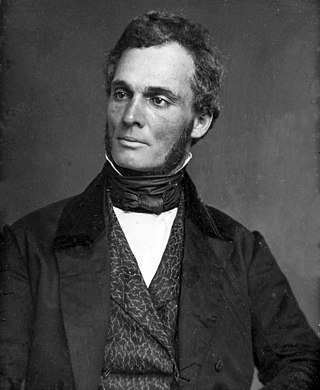
Robert Purvis was an American abolitionist in the United States. He was born in Charleston, South Carolina, and was likely educated at Amherst Academy, a secondary school in Amherst, Massachusetts. He spent most of his life in Philadelphia, Pennsylvania. In 1833 he helped found the American Anti-Slavery Society and the Library Company of Colored People. From 1845 to 1850 he served as president of the Pennsylvania Anti-Slavery Society and also traveled to Britain to gain support for the movement.
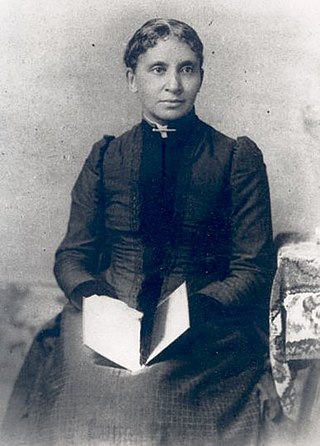
Charlotte Louise Bridges Grimké was an African American anti-slavery activist, poet, and educator. She grew up in a prominent abolitionist family in Philadelphia. She taught school for years, including during the Civil War, to freedmen in South Carolina. Later in life she married Francis James Grimké, a Presbyterian minister who led a major church in Washington, DC, for decades. He was a nephew of the abolitionist Grimké sisters and was active in civil rights.

Francis James Grimké was an American Presbyterian minister in Washington, DC. He was regarded for more than half a century as one of the leading African-American clergy of his era and was prominent in working for equal rights. He was active in the Niagara Movement and helped found the National Association for the Advancement of Colored People (NAACP) in 1909.
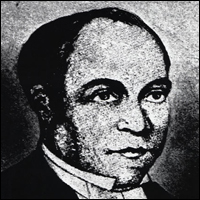
Peter Williams Jr. (1786–1840) was an African-American Episcopal priest, the second ordained in the United States and the first to serve in New York City. He was an abolitionist who also supported free black emigration to Haiti, the black republic that had achieved independence in 1804 in the Caribbean. In the 1820s and 1830s, he strongly opposed the American Colonization Society's efforts to relocate free blacks to the colony of Liberia in West Africa.

Hayes Farm, also known as Hayes Plantation, is a historic plantation near Edenton, North Carolina that belonged to Samuel Johnston (1733–1816), who served as Governor of North Carolina from 1787 to 1789. Johnston became one of the state's first two United States Senators, serving from 1789 until 1793, and served later as a judge until retiring in 1803. Samuel Johnston died in 1816 at "the Hermitage," his home near Williamston in Martin County, N.C. The residence known as Hayes was completed by his son, James Cathcart Johnston, a year after Samuel's death. There are numerous other structures on the property, some predating the Hayes house itself, including the Hayes Gatehouse, which James Johnston lived in prior to the construction of the Hayes house.
Margaret Hope Bacon was an American Quaker historian, author and lecturer. She is primarily known for her biographies and works involving Quaker women’s history and the abolitionist movement. Her most famous book is her biography of Lucretia Mott, Valiant Friend, published in 1980.
Margaretta Forten was an African-American suffragist and abolitionist.
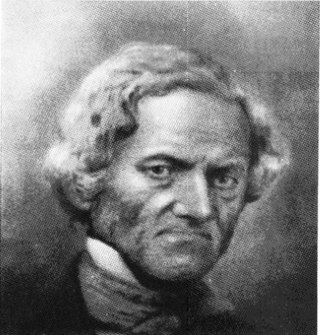
John Pierre Burr was an American abolitionist and community leader in Philadelphia, Pennsylvania, active in education and civil rights for African Americans. He was an illegitimate child of Aaron Burr, the third U.S. vice president, and Mary Emmons, a Haitian governess who may have been born in Calcutta, India.

Harriet Forten Purvis was an African-American abolitionist and first generation suffragist. With her mother and sisters, she formed the first biracial women's abolitionist group, the Philadelphia Female Anti-Slavery Society. She hosted anti-slavery events at her home and with her husband Robert Purvis ran an Underground Railroad station. Robert and Harriet also founded the Gilbert Lyceum. She fought against segregation and for the right for blacks to vote after the Civil War.
Grace Bustill Douglass was an African-American abolitionist and women's rights advocate. Her family was one of the first prominent free black families in the United States. Her family's history is one of the best documented for a black family during this period, dating from 1732 until 1925.

The history of African Americans or Black Philadelphians in the city of Philadelphia, Pennsylvania has been documented in various sources. People of African descent are currently the largest ethnic group in Philadelphia. Estimates in 2010 by the U.S. Census Bureau documented the total number of people living in Philadelphia who identified as Black or African American at 644,287, or 42.2% of the city's total population.
Robert Douglass Jr. was an African-American artist and leading activist from Philadelphia.
Rev. Stephen Smith (1797–1873) was an African American businessman, philanthropist, preacher, real estate developer, and abolitionist. He had lived in Pennsylvania in the 19th-century and contributed large amounts of his wealth in the effort to abolish slavery. Smith had been an agent of the Underground Railroad in Philadelphia. He co-founded and owned "Smith, Whipper & Co." a lumber business in Columbia, Pennsylvania; and later helped found the "Stephen Smith Home for the Aged".
Amy Matilda Williams Cassey was an African American abolitionist, and was active with the Philadelphia Female Anti-Slavery Society. Cassey was a member of the group of elite African Americans who founded the Gilbert Lyceum, Philadelphia's first co-ed literary society. The society had more than forty registered members by the end of the first year.
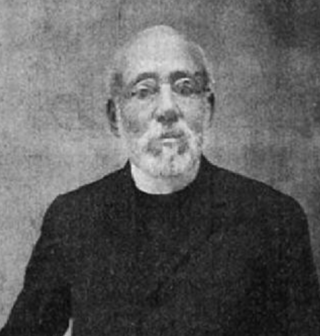
Rev. Peter William Cassey (1831–1917) was an African-American 19th-century school founder, deacon, minister, educator, abolitionist, and political activist. He was a pioneer in Santa Clara County. Cassey founded the first African American secondary school in the state of California, the Phoenixonian Institute. Cassey also worked as a prominent barber and co-owned a shaving saloon in San Francisco; and had worked as Methodist clergy in North Carolina and Florida. His name was sometimes written as Peter Williams Cassey.
Cassey is a feminine given name and a surname, as well as a place name. Cassey may refer to:
Joseph Cassey (1789–1848) was a French West Indies-born American businessman, real estate investor, abolitionist, and activist. He prospered as a barber, and as well as a wig maker, perfumer, and money-lender. He lived in the historic Cassey House in Society Hill, and was active in the African American elite community in Philadelphia.
The 1834 Philadelphia race riot, also known as the Flying Horses riot, was an instance of communal violence in Philadelphia, Pennsylvania, United States. The riot, in which a mob of several hundred white people attacked African Americans living in the area, began on the evening of August 12 and lasted for several days, dying down by August 14.













